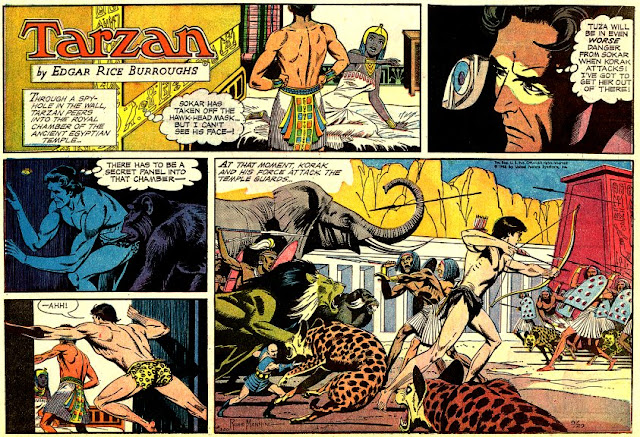Korak is the Honorable Jack Clayton, son of English Lord John Clayton, Viscount Greystoke, also known as Tarzan, lord of the jungle. He is the hero of a 1915/6 magazine serial and 1917 novel by American writer Edgar Rice Burroughs and a 1920 silent movie serial, as well as a character in several other Tarzan stories from 1914 to 1924. He experienced a revival in 1964 as the star of his own comic book series and as a major character in various Tarzan comic books, pages, and strips from 1966 to 1978.
As depicted in the comic books, pages, and strips, Korak has a lean, athletic physique, broad shoulders and thin waist, almost no clothing, a cute, boyish face, and full, thick hair. He is also an intelligent, enthusiastic teen-aged boy with excellent natural instincts and a good heart.
Korak strives to emulate his legendary father but lacks his
strength, maturity and experience. Therefore, he is both more likely
to enter into dangerous situations and more vulnerable to being
defeated.
 |
Korak in Daily Tarzan (9/30/1968)
|
 |
Korak in Daily Tarzan (10/1/1968)
|
 |
Korak in Daily Tarzan (10/2/1968)
|
 |
| Korak in Daily Tarzan (10/3/1968) |
 |
| Korak in Daily Tarzan (10/4/1968) |
 |
| Korak in Daily Tarzan (10/5/1968) |
As the star of his own comic book series in 1964, Korak is a capable, young hero. His adventures were somewhat similar to those of his father Tarzan, but independent from them.
In 1966, ABC released the TV series Batman, featuring the frequently imperiled youthful sidekick Robin the Boy Wonder. As a fan of seeing cute, young sidekicks in trouble, I watched every episode.
Russ Manning took over the Daily Tarzan strips in 1967. His Korak tended to have a tall, lean, swimmer's build. While
the son of Tarzan continued to have somewhat autonomous adventures, the
slender, handsome youth seemed to be getting into trouble more frequently and more easily. Moreover, in the Daily Tarzan strips, Korak tended to suffer from more frequent comparisons to his legendary father.
Previous to this week's adventures, the Ho-dons
believe that Korak is Dor-Ul-Otho, son of their god, which belief the
son of Tarzan encourages in hopes that it would help him find his
father. Korak saves the fugitive renegade Ab from a sabre-tooth tiger,
enters the Ho-don city of Ta-lur as the son of its god, attracts the seductive attention of the lovely and crafty Ju-ra, who rules the city's priests through Ab's father Be-jub, and defeats its king Ta-den in a fight. Upon learning that Tarzan rides with their Waz-don enemies, the king takes advantage of the news to turn the city against Korak. Ta-den orders Korak to ride with him into battle against Tarzan and the Waz-dons. Korak spots Tarzan with the Waz-dons and rather foolishly attempts to escape the Ho-don army and reach his father. Not
surprisingly, the Ho-dons react by hurling spears at Korak in order to
prevent the apparent defection. One strikes his leg, turning the young hero into an easy target. Fortunately, Tarzan cleverly focuses the Waz-don and Ho-don warriors back upon their mutual enmity, and away from his vulnerable son.
Korak remains in a supporting role this week. Fortunately, the action concludes, and the setup for the next adventures occurs. Tarzan and his youthful son part company, carrying with it the potential for future solo adventures for Korak. However, as a parting reminder of our young hero's inexperience, he is forced to admit that he does not know how to get home. Perhaps Tarzan should pin a map to his loincloth.
Manning's
artwork is wonderful. Korak is, once again, in the background this
week. However, Tarzan continues to be having trouble
keeping his hands off his handsome, young son.
Favorite scene: 10/1/1968, panel c.
Previous strip: Korak in Daily Tarzan (9/23/1968-9/28/1968)
This blog is intended to raise interest in and appreciation of the Edgar Rice Burroughs character Korak. To see this story in context, you may find it in Hillman's ERBzine at the following link:
This week's adventures can also be found at the following link(s):
https://www.erbzine.com/mag26/2630.html































